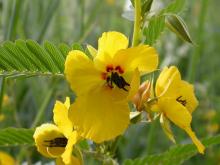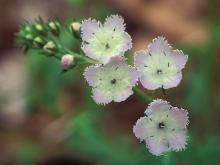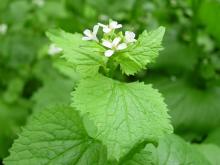Wildflowers, Grasses and Other Nonwoody Plants
Media

Species Types
Scientific Name
Chamaecrista fasciculata (formerly Cassia fasciculata)
Description
The interesting, bright yellow flowers of showy partridge pea are immediately recognizable. At night, the leaflets close and pull upward into a sleeping position.
Media

Species Types
Scientific Name
Viola sororia
Description
The common violet can be violet, white, or white with violet mottling or spots. One of 17 species or violets in Missouri, it occurs statewide in a variety of habitats. Note its heart-shaped or rounded, scalloped leaves, and (usually) the presence of hairs on stems and/or foliage.
Media

Species Types
Scientific Name
Viola pubescens (formerly V. pensylvanica)
Description
The yellow violet is Missouri's only all-yellow violet. This native wildflower is less common than violet violets. Look for it in low woods, rich slopes, and wooded floodplains.
Media

Species Types
Scientific Name
Securigera varia (formerly Coronilla varia)
Description
In summer, you’re almost guaranteed to see big colonies of crown vetch along Missouri's highways. This weedy nonnative plant stabilizes the dirt after road construction but degrades our natural ecosystems.
Media

Species Types
Scientific Name
Phacelia purshii
Description
An annual, spring-blooming wildflower, Miami mist has loose coils of small blue flowers with distinctive, delicate fringes on the petal lobes.
Media

Species Types
Scientific Name
Viola bicolor
Description
Johnny-jump-up is a flat-faced violet whose small flowers are a washed-out blue or violet with a very light yellow or white center. Look for it in fields, meadows, glades, rights-of-way, disturbed sites, and possibly your front lawn.
Media

Species Types
Scientific Name
Microstegium vimineum
Description
Japanese stiltgrass is an invasive annual grass with thin, pale green, lance-shaped leaves that are 3 inches long. It has spread to nearly every eastern U.S. state. It forms dense patches, displacing and outcompeting native species for nutrients and light.
Media
Species Types
Scientific Name
Vernonia baldwinii
Description
Ironweeds are tough, grayish-green, branching plants known for their fluffy-looking clusters of reddish-purple florets. They are a familiar sight on roadsides and pastures. Identify western ironweed by the bracts at the base of the flowerheads.
Media

Species Types
Scientific Name
Maianthemum racemosum (formerly Smilacena racemosa)
Description
False Solomon's seal can be distinguished from "true" Solomon's seal by differences in flower shape and placement, the color of the berries, and some characteristics of the leaves.
Media

Species Types
Scientific Name
Alliaria petiolata
Description
Because each plant disperses a large number of seeds, garlic mustard can outcompete native vegetation for light, moisture, nutrients, soil, and space as it quickly colonizes an area.
See Also
About Wildflowers, Grasses and Other Nonwoody Plants in Missouri
A very simple way of thinking about the green world is to divide the vascular plants into two groups: woody and nonwoody (or herbaceous). But this is an artificial division; many plant families include some species that are woody and some that are not. The diversity of nonwoody vascular plants is staggering! Think of all the ferns, grasses, sedges, lilies, peas, sunflowers, nightshades, milkweeds, mustards, mints, and mallows — weeds and wildflowers — and many more!





















